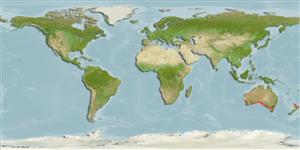Environment: milieu / climate zone / depth range / distribution range
Ecología
marino; salobre asociado a arrecife; rango de profundidad ? - 90 m (Ref. 9563). Temperate; 26°S - 43°S
Indo-Pacific: Endemic to Australia.
Tamaño / Peso / Age
Maturity: Lm ? range ? - ? cm
Max length : 50.0 cm TL macho / no sexado; (Ref. 7300)
Espinas dorsales (total): 9; Radios blandos dorsales (total): 14-15; Espinas anales 3; Radios blandos anales: 14 - 15; Vértebra: 26. Adults are silver to brown with black vertical stripes (Ref. 33616).
Juveniles live in estuaries (Ref. 33616) while adults occur in estuaries and on inshore and offshore rocky reefs and seagrass beds (Ref. 9563). Found either in large schools, in pairs or as solitary individuals (Ref. 33616). Neither anterolateral glandular groove nor venom gland is present (Ref. 57406). Reported to have venomous fin spines without associated venom gland (https://fishesofaustralia.net.au/home/species/445#moreinfo).
Life cycle and mating behavior
Madurez | Reproducción | Puesta | Huevos | Fecundidad | Larva
Paxton, J.R., D.F. Hoese, G.R. Allen and J.E. Hanley, 1989. Pisces. Petromyzontidae to Carangidae. Zoological Catalogue of Australia, Vol. 7. Australian Government Publishing Service, Canberra, 665 p. (Ref. 7300)
IUCN Red List Status (Ref. 130435)
Threat to humans
Venomous
Human uses
Pesquerías: escaso valor comercial; Acuario: Comercial
Más información
ReferenciasAcuiculturaPerfil de acuiculturaRazasGenéticaElectrophoresesheritabilidadEnfermedadesProcesamientoNutrientsMass conversion
ColaboradoresImágenesStamps, Coins Misc.SonidosCiguateraVelocidadTipo de nataciónSuperficie branquialOtolitosCerebrosVisión
Herramientas
Special reports
Download XML
Fuentes de Internet
Estimates based on models
Preferred temperature (Ref.
123201): 15.3 - 20.6, mean 17.7 °C (based on 232 cells).
Phylogenetic diversity index (Ref.
82804): PD
50 = 1.5000 [Uniqueness, from 0.5 = low to 2.0 = high].
Bayesian length-weight: a=0.00389 (0.00180 - 0.00842), b=3.12 (2.94 - 3.30), in cm total length, based on all LWR estimates for this body shape (Ref.
93245).
Nivel trófico (Ref.
69278): 3.3 ±0.40 se; based on food items.
Fishing Vulnerability (Ref.
59153): Moderate vulnerability (40 of 100).
Nutrients (Ref.
124155): Calcium = 17.9 [7.0, 29.5] mg/100g; Iron = 0.206 [0.104, 0.363] mg/100g; Protein = 19.1 [18.0, 20.2] %; Omega3 = 0.243 [0.127, 0.478] g/100g; Selenium = 11 [5, 27] μg/100g; VitaminA = 30.6 [7.8, 118.3] μg/100g; Zinc = 0.744 [0.478, 1.193] mg/100g (wet weight);
